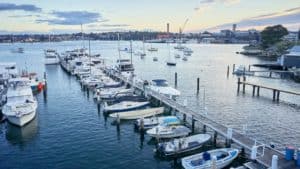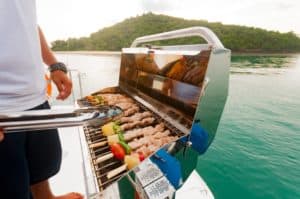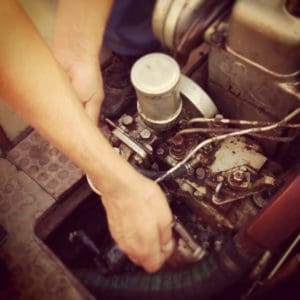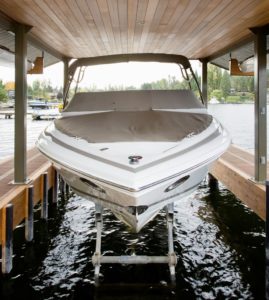Moisture is the leading cause of corrosion, making boats highly vulnerable to accelerated deterioration. Not only can water cause damage but the moisture in the air can do so as well. Add salt to the mix and corrosion can become a major problem for many boat owners.
Actively monitoring your boat for corrosion can help ensure its longevity and functionality. In this guide, you’ll learn about the different types of corrosion and the steps you take to help prevent them.
Types Of Corrosion And Their Causes
Corrosion is the gradual destruction of materials caused by chemical and (or) electrochemical reaction with their environment. There are three distinct types of corrosion your vessel is susceptible to. Let’s take a look at how they occur and how quickly the metal is compromised.
Simple Corrosion
Over time, most metals will corrode with exposure to oxygen and the presence of moisture. For example, consider the gray dust that forms on bare aluminum or the red discoloration of rusted iron.
Simple corrosion often takes years or decades to weaken the metal, making it less problematic than other types of corrosion.
Galvanic Corrosion
This type of corrosion occurs when two metals with different electrical potentials are connected together and submerged into a conductive solution such as seawater. For example, a bronze propeller on a stainless steel shaft or a stainless steel bolt threaded into an aluminum mast regularly placed in seawater.
Dissimilar metals in a conductive solution create a battery with a cathode and an anode. Which metal is the cathode and which is the anode depends on their relative voltage when submerged in seawater. The metal with the more negative voltage has more electrons relative to the other metal and will act as the anode, meaning it will send negatively charged ions to the cathode (the metal with the higher voltage).
Over time, this ion flow will lead to a loss of material in the anode. How long this takes to occur depends on the size of the difference in the electrical potential between the two metals. This is measured by the galvanic series of metals. The farther apart the metals are in the series, the faster the corrosion will occur. If left untreated, galvanic corrosion can cause significant damage in just months.
Electrolytic Corrosion
Also known as ‘stray current corrosion’, this type of corrosion occurs when an external electrical source is added to the equation. It occurs when any metal with an electrical current flowing into it is submerged in water that is grounded, such as a lake or ocean.
For example, if an electrical short develops between an external current source such as a 12-volt electrical system on your boat and some part of the electrical system that is connected to the boat’s underwater metals, the stray current will exit the boat from the underwater metal (potentially in much greater magnitude than the natural voltage levels). This results in a rapid reaction that can cause significant metal damage in days or even hours.
Protecting Your Boat From Galvanic Corrosion
The primary method to prevent galvanic corrosion is a technique called cathodic protection. It involves adding a sacrificial anode that is less noble (lower on the galvanic table) than the rest of the metals on the boat. The sacrificial anode helps protect the metals from corrosion by taking on most of the formed electrical charge.
Cathodic protection is a little more complex when your boat has a variety of metals, as most boats do. Many of these metals are under the waterline and have their own voltage.
A potential solution to this problem is to tie all disparate metals into a single cathode in a process known as bonding. Bonding allows the dissimilar metals to achieve an equalized electrical potential (voltage). It’s important to be extra vigilant when using bonding. A DC fault in the bonding system could lead to electrolytic corrosion and rapid deterioration of the metals.
Your choice of anode material will depend on the different metals of your vessel. Here are some of the more popular types of anodes:
- Zinc: Zinc was the go-to anode material when boats were made out of fiberglass and most underwater metals were bronze except for the prop shaft. It has lost popularity recently but still works well in a true saltwater environment. As water becomes more brackish to fresh, zinc becomes less effective.
- Magnesium: Magnesium is the most expensive anode material. It’s the least noble metal on the list and runs out of electrons quickly. This anode material should only be used in clean fresh water.
- Aluminum: Aluminum anodes work well in both brackish and saltwater. This is because the alloy used the anodes contains iridium and other metals that inhibit the oxidation of aluminum. The alloy in high-quality nodes will protect aluminum hulls and sterndrives.
Stainless Steel On Marine Vessels
Marine-grade stainless steel contains nickel, molybdenum, and nitrogen as well as 10% chromium as this combination is designed for use in harsh marine environments. It offers a potential way to mitigate the deterioration of your vessel as the material is built to resist corrosion and pitting. It can also maintain its strength at high temperatures and is easy to maintain.
While stainless steel is made to resist corrosion, it’s not completely corrosion-proof. Exposure to a lot of moisture and harsh conditions such as tropical climates or salt water can cause the material to oxidize or corrode.
Tips For Protecting Your Boat
For better boat hull protection and to preserve stainless steel and other metal fittings, practice the following care and boat maintenance tips:
- Always use a soft, non-abrasive wiping cloth or sponge along with freshwater and a mild cleaner when cleaning stainless steel fixtures.
- Eliminate excess moisture in your storage area to help keep your boat free of rust and mildew during storage. You can do this by using a climate-controlled unit, running a dehumidifier in the unit, or by using silica gel packs.
- Regularly hose down the deck and all stainless steel components using freshwater to significantly reduce the potential of corrosion, especially after a period of use or exposure to seawater.
- Use naval jelly or phosphoric acid as a rust inhibitor on stainless steel. You can also use these substances to remove rust.
Conclusion
If you’re planning your next boating adventure, Corleone Marinas provides harbor locations at Sydney’s most prestigious sites including Elizabeth Bay, Long Island, Balmain and Drummoyne. Each site offers a variety of options including berths, moorings, on-site slipways and shipwrights. If you need maintenance or repairs for your vessel due to corrosion, we can help! Contact us today to learn about our full range of marina services.






